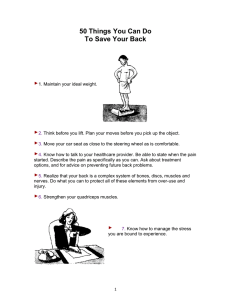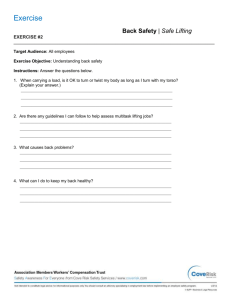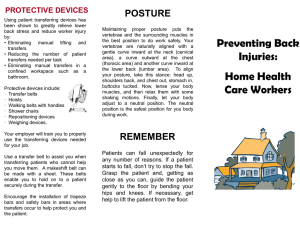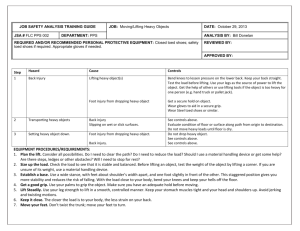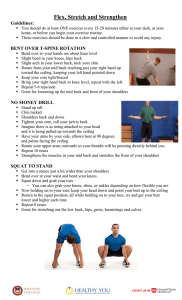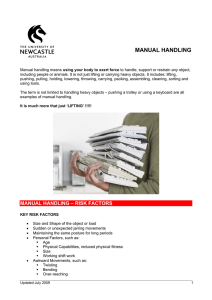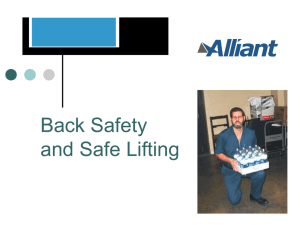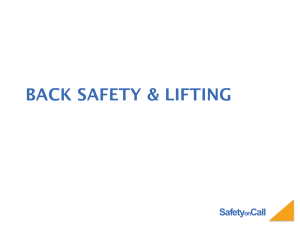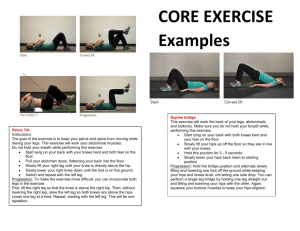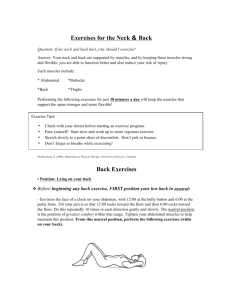Series 300-Ergonomics - Green River District Health Department
advertisement
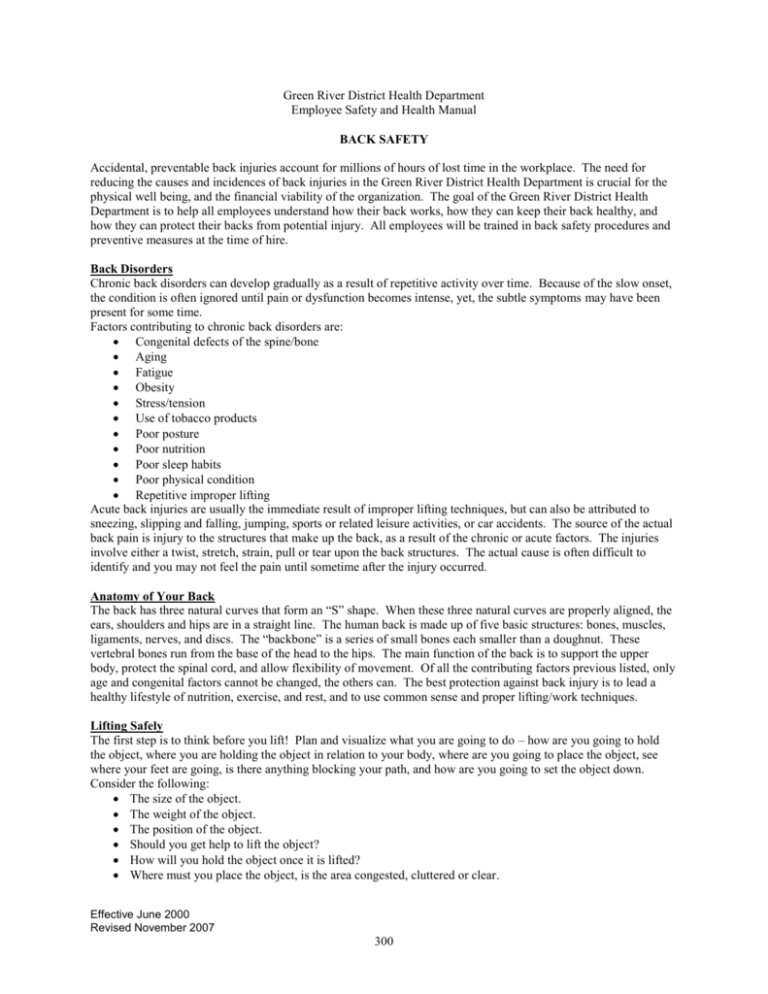
Green River District Health Department Employee Safety and Health Manual BACK SAFETY Accidental, preventable back injuries account for millions of hours of lost time in the workplace. The need for reducing the causes and incidences of back injuries in the Green River District Health Department is crucial for the physical well being, and the financial viability of the organization. The goal of the Green River District Health Department is to help all employees understand how their back works, how they can keep their back healthy, and how they can protect their backs from potential injury. All employees will be trained in back safety procedures and preventive measures at the time of hire. Back Disorders Chronic back disorders can develop gradually as a result of repetitive activity over time. Because of the slow onset, the condition is often ignored until pain or dysfunction becomes intense, yet, the subtle symptoms may have been present for some time. Factors contributing to chronic back disorders are: Congenital defects of the spine/bone Aging Fatigue Obesity Stress/tension Use of tobacco products Poor posture Poor nutrition Poor sleep habits Poor physical condition Repetitive improper lifting Acute back injuries are usually the immediate result of improper lifting techniques, but can also be attributed to sneezing, slipping and falling, jumping, sports or related leisure activities, or car accidents. The source of the actual back pain is injury to the structures that make up the back, as a result of the chronic or acute factors. The injuries involve either a twist, stretch, strain, pull or tear upon the back structures. The actual cause is often difficult to identify and you may not feel the pain until sometime after the injury occurred. Anatomy of Your Back The back has three natural curves that form an “S” shape. When these three natural curves are properly aligned, the ears, shoulders and hips are in a straight line. The human back is made up of five basic structures: bones, muscles, ligaments, nerves, and discs. The “backbone” is a series of small bones each smaller than a doughnut. These vertebral bones run from the base of the head to the hips. The main function of the back is to support the upper body, protect the spinal cord, and allow flexibility of movement. Of all the contributing factors previous listed, only age and congenital factors cannot be changed, the others can. The best protection against back injury is to lead a healthy lifestyle of nutrition, exercise, and rest, and to use common sense and proper lifting/work techniques. Lifting Safely The first step is to think before you lift! Plan and visualize what you are going to do – how are you going to hold the object, where you are holding the object in relation to your body, where are you going to place the object, see where your feet are going, is there anything blocking your path, and how are you going to set the object down. Consider the following: The size of the object. The weight of the object. The position of the object. Should you get help to lift the object? How will you hold the object once it is lifted? Where must you place the object, is the area congested, cluttered or clear. Effective June 2000 Revised November 2007 300 Green River District Health Department Employee Safety and Health Manual Safe Steps to Use for the Protection of Your Back Before lifting anything, plan the lift. Feet should be placed at least shoulder width apart with one foot positioned in front of the other for good balance. Take a deep breath and tighten your stomach muscles. When lifting, bend at your knees and hips, not at your waist. This helps maintain the natural curvature of the spine. This natural curvature equalizes the pressure exerted allowing it to be absorbed evenly across the entire surface of the disc. Use a secure palm grip. This gives you a stronger, steadier, more secure hold on the object. Hold the object as close to your body as possible. Lifting or carrying something in an awkward way can be just as damaging as lifting heavy objects. Never attempt to catch a falling object. The force of gravity with the jerking motion of trying to catch an accidentally dropped object can cause a back strain, ligament or disc damage. Lift using your leg muscles and in a smooth motion, do not jerk as you lift. Sudden movements and weight shifts can injure your back. Keep your back in alignment, with your ears, shoulders and hips lined up. Your nose and toes should be facing the load when lifting. Always keep the load close to your body. If an object must be moved in a different direction after it has been lifted, turn the feet and body in the desired direction. Do not twist or stretch during the lift. Get help if the load is too heavy. Always test the load before lifting. Other Back Safety Tips Whenever possible push a load instead of pulling it. Place the hands on the object and bend the elbows and knees. Place one foot forward and push ahead with back leg, taking short steps. Do not lean into the load. Push with the legs instead of the back. If the load must be pulled - get a firm grip on it. Bend the elbow and knees. Place one foot back for balance, and pull with the forward leg while taking short steady steps. Do not arch the back while pulling. Use a work chair that fits, with good support for the lower back - a seat back that can tilt ten degrees backward and is tall and wide enough to give full support. The thighs should be level and parallel to the floor when the feet are flat on the floor. Later, adjust the seat height slightly up or down for comfort. Use a desk or table height appropriate for work, high enough that the neck is not bent constantly, and you do not have to lean forward to rest your elbows on the desk. Adjust the computer monitor to eliminate the need to raise and lower the head to look at the screen or keyboard is preferred. Exercise to strengthen and increase flexibility in the muscles and joints that support the back. At least fifteen minutes a day, three to five times a week is sufficient time to condition the muscles that keep the back healthy. Strengthening the abdominal muscles, which support and align the spine, strengthening the leg muscles that are used in lifting and improving flexibility are all recommended. Stand up tall and walk for a few minutes every hour or so to combat joint stiffness. Move the car seat forward so the knees are bent. Keep hips all the way back in the seat. A small cushion at the low back may help. Sit up tall and straight. Do not lean to one side. Keep shoulders back, do not slouch. When working with patients in bed, raise or lower the bed, as needed, so you do not have to bend over to work with the patient. Sit on the side of the bed or in a chair when possible. Have the patient assist with movement as much as possible, or get help to move them if needed. If you know that the action will cause strain or pain - DO NOT DO IT! Effective June 2000 Revised November 2007 301 Green River District Health Department Employee Safety and Health Manual WAYS TO PROTECT YOURSELF WHILE YOU ARE WORKING AT A KEYBOARD Keep your head level and erect. Do not arch your neck downward. Your eyes should be even with the lower two-thirds of the display screen. You can adjust the brightness of your screen, size of print on your screen and the colors to help avoid eye fatigue. Your forearms should be held slightly above and parallel to the keyboard. Your shoulders should be straight and not rounded forward. Do not lean on the keyboard. Your wrists should remain straight, and float above the surface of the keyboard. Your fingers should be rounded and loose. Keep your wrists in natural alignment with your fingers Your mouse should be the same height as your keyboard and kept as close to the body as possible, to avoid reaching. Your knees and hips should be even. Keep upper and lower legs at a right angle and both feet should be flat on the floor. On your break, walk around, stretch your fingers out, shrug your shoulders and relax. Ask your supervisor for assistance with the adjustments you may need to make to your chair, keyboard shelf and monitor or display screen. ACTIVITIES THAT CAN BE DONE AT YOUR WORKSTATION TO HELP YOU RELAX Do the activities below as you are able and at your own pace. It is your body. Protect it. 1. 2. 3. 4. 5. 6. 7. 8. D-E-E-P Breathing: Breathe in slowly through your nose, hold for 2 full seconds (counting 1-mississippi, 2-mississippi in your head), and then exhale slowly through your mouth. Repeat 10 times. Head–n-Neck Turns: Gently and slowly, turn your head from one side to the other, holding each turn for a count of 3 (counting your head the Mississippi way). Repeat 5 to 10 times. Shoulder swoops: Roll your shoulders forward 5 times, using a wide, circular motion. Then roll your shoulders backward. Repeat 5 to 10 times. Upper back stretch: Place hands together behind your back on your waist, then push your elbows straight back. Hold a few seconds for a nice stretch in your shoulder blades. Repeat 5 to 10 times. Lower back stretch: While sitting, slowly bend your upper body between your knees. Hold for a few seconds, then sit up and relax. Wrist relief: Hold your arms straight out, palms down, in front of you. Raise and lower your hands to stretch the muscles in your forearm. Repeat several times. Help for your hands and fingers: Make a tight fist with your hands. Hold for a Mississippi second, and then spread your fingers as far apart as you can. Hold for 5 Mississippi seconds. Repeat. Leg-up: While seated, grasp the shin of one leg and pull slowly toward your chest. Hold for 5 Mississippi seconds. Then do the other leg. Repeat several times. Be careful with this one and do not fall out of your chair. Effective June 2000 Revised November 2007 302
